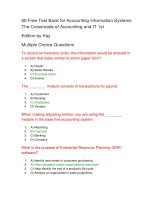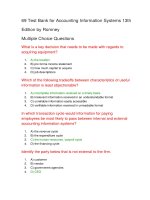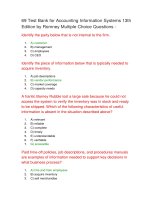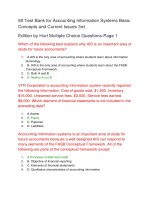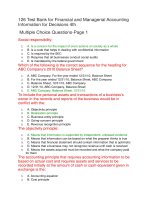153 test bank for managerial accounting 12th edition
Bạn đang xem bản rút gọn của tài liệu. Xem và tải ngay bản đầy đủ của tài liệu tại đây (161.32 KB, 30 trang )
153 Test Bank for Managerial Accounting 12th Edition
True False Questions - Free Text Questions - Multiple Choice
Questions
Costs other than direct materials cost and direct labor cost
incurred in the manufacturing process are classified as:
1.
period cost
2.
miscellaneous expense
3.
factory overhead cost
4.
product costs
Cost of goods manufactured is equal to:
1.
total manufacturing costs plus beginning work in process inventory less ending work in
process inventory
2.
total manufacturing costs plus ending work in process inventory less beginning work in
process inventory
3.
cost of goods sold plus beginning work in process inventory less ending work in
process inventory
4.
total manufacturing costs plus ending materials inventory less beginning materials
inventory
Beginning Raw Materials Inventory:$40,000; Materials
purchased:$65,000; Ending Raw Materials Inventory:
$30,000. What is the amount of Raw Materials Used?
1.
$75,000
2.
$5,000
3.
$65,000
4.
$30,000
A company manufactured 50,000 units of a product at a cost of
$450,000. They sold 40,000 units for $15 each. What is the
gross margin?
1.
$600,000
2.
$450,000
3.
$240,000
4.
$750,000
Compute conversion costs given the following data: Direct
Materials, $347,500; Direct Labor, $186,300; Factory
Overhead, $187,900; and Selling Expenses, $45,290.
1.
$374,200
2.
$721,700
3.
$533,800
4.
$187,900
All of the following employees hold line positions in Anthea
Electric EXCEPT:
1.
vice president of sales
2.
vice president of finance
3.
manager of the Valhalla Plant
4.
vice president of production
All of the following would be reported on the balance sheet as a
current asset except:
1.
factory overhead
2.
materials inventory
3.
work in process inventory
4.
finished goods inventory
All of the following are ways that managers use managerial
information except
1.
to evaluate the company’s stock performance
2.
to evaluate the performance of a company’s operations
3.
to determine the cost of manufacturing a product
4.
to support long-term planning decisions
Cost of Materials Used: $45,000; Direct Labor costs: $48,000;
Factory Overhead: $39,000; Work in Process, beg.:
$28,000; Work in Process, end.: $18,000. What is Cost of
Goods Manufactured?
1.
$132,000
2.
$178,000
3.
$122,000
4.
$142,000
A company sells goods for $150,000 that cost $60,000 to
manufacture. Which statement(s) are true?
1.
The company will recognize sales on the balance sheet of $150,000.
2.
The company will decrease finished goods by $60,000.
3.
All of these are true.
4.
The company will recognize $90,000 gross profit on the balance sheet.
Accounting designed to meet the needs of decision-makers
inside the business is referred to as:
1.
general accounting
2.
financial accounting
3.
managerial accounting
4.
external accounting
Another term often used to refer to factory overhead is:
1.
supervisory cost
2.
surplus
3.
factory burden
4.
period cost
All of the following would probably be considered a direct
material except:
1.
glue
2.
fabric
3.
steel
4.
lumber
Cost of goods manufactured during 2011 is $240, work in
process inventory on December 31, 2011, is $50. Work in
process inventory during 2011 decreased by 60%. Total
manufacturing costs incurred during 2011 amount to:
1.
$290
2.
$315
3.
$190
4.
$165
A product cost is:
1.
expensed in the period in which it is incurred
2.
expensed in the period the product is sold
3.
shown with current liabilities on the balance sheet
4.
shown on the income statement with the operating expenses
All of the following are examples of indirect labor except:
1.
plant managers
2.
maintenance personnel
3.
janitorial personnel
4.
machine operators
Cost of goods sold for a manufacturer equals cost of goods
manufactured plus:
1.
ending work in process inventory less beginning work in process inventory
2.
ending finished goods inventory less beginning finished goods inventory
3.
beginning work in process inventory less ending work in process inventory
4.
beginning finished goods inventory less ending finished goods inventory
Conversion costs are
1.
direct materials and direct labor
2.
factory overhead and direct labor
3.
direct materials and indirect labor
4.
direct materials and factory overhead
Beginning work in process is equal to:
1.
cost of goods manufactured plus ending work in process minus manufacturing costs
incurred during the current period
2.
manufacturing costs incurred during the current period minus ending work in process
3.
ending work in process plus manufacturing costs incurred during the current period
4.
cost of goods manufactured minus ending work in process plus manufacturing costs
incurred during the current period
An example of a period cost is:
1.
depreciation on factory equipment
2.
indirect materials
3.
property taxes on plant facilities
4.
advertising expense
Cost of Materials Used:$45,000; Direct Labor costs: $48,000;
Factory Overhead: $39,000; Work in Process, beg:
$28,000;Work in Process, end: $18,000; Finished
Goods,beg.: $28,000; Finished Goods, end.:$18,000. What
is Cost of Goods Sold?
1.
$152,000
2.
$10,000
3.
$142,000
4.
$128,000
At the beginning of 2011, the Gilbert Company’s work in
process inventory account had a balance of $30,000.
During 2011, $68,000 of direct materials were used in
production, and $66,000 of direct labor costs were
incurred. Factory overhead in 2011 amounted to $90,000.
Cost of goods manufactured is $230,000 in 2011. The
balance in work in process inventory on December 31,
2011, is:
1.
$36,000
2.
$24,000
3.
$44,000
4.
$66,000
A plant manager’s salary may be referred to as:
1.
a period cost
2.
a direct cost
3.
an indirect cost
4.
either a direct cost or an indirect cost since managerial accounting is not restricted by
GAAP
A company used $35,000 of direct materials, incurred $73,000 in
direct labor cost, and $114,000 in factory overhead costs
during the period. If beginning and ending work in
process inventories were $28,000 and $32,000
respectively, the cost of goods manufactured was:
1.
$226,000
2.
$222,000
3.
$218,000
4.
$190,000
Costs on the income statement for both a merchandiser and a
manufacturer would include:
1.
direct labor incurred
2.
cost of goods manufactured
3.
direct materials
4.
operating expenses
84 Free Test Bank for Managerial Accounting 12th Edition
by Warren Multiple Choice Questions - Page 2
The cost of a manufactured product generally consists of which
of the following costs?
1.
Direct materials cost and direct labor cost
2.
Direct labor cost, direct materials cost, and factory overhead cost
3.
Direct materials cost and factory overhead cost
4.
Direct labor cost and factory overhead cost
Goods that are partially completed by a manufacturer are
referred to as:
1.
merchandise inventory
2.
work in process inventory
3.
finished goods inventory
4.
materials inventory
Indirect labor and indirect materials are classified as:
1.
operating costs and period costs
2.
operating costs and product costs
3.
factory overhead and period costs
4.
factory overhead and product costs
Period costs include:
1.
operating costs that are shown on the income statement in the period in which they are
incurred
2.
operating costs that are shown on the income statement when products are sold
3.
current liabilities on the balance sheet
4.
current assets on the balance sheet
The Sharpe Company reports the following information for
2015: Sales: $76,500; Direct materials used: 7,300;
Depreciation on factory equipment: 4,700; Indirect labor:
5,900; Direct labor: 10,500; Factory rent: 4,200; Factory
utilities: 1,200; Sales salaries expense: 15,600; Office
salaries expense: 8,900; Indirect materials: 1,200;
Determine product costs for 2015.
1.
$24,500
2.
$35,000
3.
$30,300
4.
$29,200
Managerial accounting
1.
is related to the entire business entity only.
2.
is prepared according to management needs.
3.
is prepared according to GAAP.
4.
is prepared periodically only.
Managerial accountants would most likely prepare all of the
following reports except:
1.
A control report comparing direct material usage over time.
2.
A sales report targeting monthly sales and potential bonuses.
3.
An annual report for external regulators such as the SEC.
4.
A performance report identifying amounts of scrap.
Finished goods inventory is reported on the:
1.
balance sheet as a long-term asset
2.
balance sheet as a current asset
3.
income statement as revenue
4.
income statement as a period cost
Indirect costs incurred in a manufacturing environment that
cannot be traced directly to a product are treated as:
1.
period costs and expensed when incurred
2.
period costs and expensed when the goods are sold
3.
product costs and expensed when the goods are sold
4.
product costs and expenses when incurred
Costs which are reported on the income statement as part of
cost of goods sold are referred to as:
1.
operating expenses
2.
period costs
3.
administrative expenses
4.
cost of goods manufactured
Materials must have which two qualities in order to be classified
as direct materials?
1.
They must be an integral part of the finished product and be a significant portion of the
total product cost.
2.
They must be classified as both prime costs and conversion costs.
3.
They must be introduced into the process in both work-in-process inventories and
finished goods inventories.
4.
They must be an integral part of the finished product, but can be an insignificant portion
of the total product cost.
If the cost of direct materials is a small portion of total
production cost, it may be classified as part of:
1.
factory overhead cost
2.
miscellaneous costs
3.
direct labor cost
4.
selling and administrative costs
The Sharpe Company reports the following information for
2015: Sales: $76,500; Direct materials used: 7,300;
Depreciation on factory equipment: 4,700; Indirect labor:
5,900; Direct labor: 10,500; Factory rent: 4,200; Factory
utilities:1,200; Sales salaries expense: 15,600; Office
salaries expense: 8,900; Indirect materials: 1,200;
Determine period costs for 2015.
1.
$24,500
2.
$30,300
3.
$29,200
4.
$35,000
Reedy Company reports the following information for 2012:Cost
of goods manufactured:$68,250; Direct materials
used:27,000; Direct labor incurred:25,000; Work in
process inventory, January 1, 2012:11,000. Factory
overhead is 75% of the cost of direct labor. Work in
process inventory on December 31, 2012, is:
1.
$13,500
2.
$8,500
3.
$18,750
4.
$16,250
Rent expense incurred on a factory building would be treated as
a(n):
1.
indirect cost
2.
both A and C are correct
3.
product cost
4.
period cost
The controller's staff often consists of several management
accountants. All of the following would most likely be on
the controller's staff EXCEPT:
1.
general accountants
2.
cost accountants
3.
investments and shareholder relations managers
4.
budgets and budget analysts
In order to be useful to managers, management accounting
reports should possess all of the following characteristics
EXCEPT:
1.
be prepared to report information for any unit of the business to support decision
making
2.
be prepared in accordance with generally accepted accounting principles
3.
provide objective measures of past operations and subjective estimates about future
decisions
4.
be provided at any time management needs information
In the income statement of a manufacturing company, what
replaces purchases in the cost of goods section of a retail
company?
1.
Cost of merchandise available
2.
Work in process completed
3.
Finished goods
4.
Cost of goods manufactured
Direct labor and direct materials are classified as:
1.
product costs and expensed when incurred
2.
product costs and expensed when the goods are sold
3.
period costs and expensed when incurred
4.
period costs and expensed when the goods are sold
Product costs
1.
appear only on the balance sheet
2.
appear only on the income statement
3.
appear on both the income statement and balance sheet
4.
are expensed as costs are incurred for direct labor, direct material and factory
overhead
The cost of goods sold for Heedy manufacturing in 2011 was
$233,000. The January 1, 2011, finished goods inventory
balance was $31,600, and the December 31, 2011, finished
goods inventory balance was $24,200. Cost of goods
manufactured during the period was:
1.
$288,800
2.
$233,000
3.
$240,400
4.
$225,600
Factory overhead includes:
1.
indirect materials and direct materials
2.
factory rent and direct labor
3.
direct materials and direct labor
4.
indirect labor and indirect materials
Prime costs are
1.
period costs and factory overhead
2.
direct labor and factory overhead
3.
direct materials and direct labor
4.
direct materials and factory overhead
Rent expense on a factory building would be treated as a(n):
1.
both A and C are correct
2.
period cost
3.
direct cost
4.
product cost
In most business organizations, the chief management
accountant is called the:
1.
chief executive officer
2.
chief accounting officer
3.
controller
4.
chairman of the board
84 Free Test Bank for Managerial Accounting 12th Edition
by Warren Multiple Choice Questions - Page 3
The following are all product costs except:
1.
Direct labor
2.
Direct materials
3.
Sales and administrative expenses
4.
Factory overhead
Which of the following is not a prime cost?
1.
Supervisor’s wages
2.
Direct labor wages
3.
Machine operator wages
4.
Assembly line wages
Which of the following is most associated with financial
accounting?
1.
Can have both objective and subjective information
2.
Can be prepared for the entity or segment
3.
Can be prepared periodically, or as needed
4.
Prepared in accordance with GAAP
Williams Company reports production costs for 2015 as follows:
Direct materials used:$345,000; Direct labor
incurred:250,000; Factory overhead; incurred:400,000;
Operating expenses:175,000. Williams Company’s period
costs for 2015 amount to:
1.
$250,000
2.
$175,000
3.
$345,000
4.
$400,000
Work in process inventory increased by $20,000 during 2011.
Cost of goods manufactured was $180,000. Total
manufacturing costs incurred in 2011 are:
1.
$160,000
2.
$200,000
3.
$198,000
4.
$189,000
Work in process inventory on December 31, 2011, is $44,000.
Work in process inventory increased by 60% during 2011.
Cost of goods manufactured for 2011 amounts to
$275,000. What are the total manufacturing costs incurred
in 2011?
1.
$233,750
2.
$302,000
3.
$291,500
4.
$275,750
Which of the following is an example of direct labor cost for an
airplane manufacturer?
1.
Cost of oil lubricants for factory machinery
2.
Cost of wages of assembly worker
3.
Cost of jet engines
4.
Salary of plant supervisor
Williams Company reports production costs for 2015 as follows:
Direct materials used:$345,000; Direct labor
incurred:250,000; Factory overhead; incurred:400,000;
Operating expenses:175,000. Williams Company’s
product costs for 2015 amount to:
1.
$920,000
2.
$770,000
3.
$825,000
4.
$995,000
Which of the following manufacturing costs is an indirect cost
of producing a product?
1.
Memory chips for a microcomputer manufacturer
2.
Hourly wages of an assembly worker
3.
Commissions for sales personnel
4.
Oil lubricants used for factory machinery
Which of the following is not a characteristic of useful
managerial accounting reports?
1.
historical and estimated data
2.
reports prepared as needed
3.
GAAP
4.
Accuracy
What is the purpose of the Statement of Cost of Goods
Manufactured?
1.
to determine the ending materials inventory
2.
to determine the amounts transferred to finished goods
3.
to determine the ending work in process inventory
4.
all of the answers are true
Which of the following is an example of direct materials cost for
an automobile manufacturer?
1.
Cost of oil lubricants for factory machinery
2.
Cost of wages of assembly worker
3.
Salary of production supervisor
4.
Cost of interior upholstery
What is the primary criterion for the preparation of managerial
accounting reports?
1.
Cost of the reports
2.
Relevance of the reports
3.
Meet the manager needs
4.
Timing of the reports
Which of the following accounts will be found on the income
statement?
1.
work in process
2.
cost of goods sold
3.
inventory
4.
finished goods
Which of the following is not a factory overhead cost?
1.
salaries of production supervisors
2.
materials used directly in the manufacturing process of the product
3.
insurance on factory equipment
4.
property tax on factory building
What term is used to describe the process of monitoring
operating results and comparing actual results with the
expected results?
1.
Directing
2.
Planning
3.
Controlling
4.
Improving
What term is used to describe the process of developing the
organization’s objectives and translating those into
courses of action?
1.
Improving
2.
Planning
3.
Decision making
4.
Supervising
The primary goal of managerial accounting is to provide
information to:
1.
external auditors
2.
investors
3.
management
4.
creditors
Which one of the following will not be found on the balance
sheet of a manufacturing company?
1.
finished goods
2.
materials
3.
cost of goods sold
4.
work in process
Who are the individuals charged with the responsibility for
directing the day-to-day operations of a business?
1.
Customers
2.
Investors
3.
Shareholders
4.
Managers
The cost of wages paid to employees directly involved in the
manufacturing process in converting materials into
finished product is classified as:
1.
factory overhead cost
2.
direct materials cost
3.
miscellaneous costs
4.
direct labor cost
Which of the following costs are referred to as conversion
costs?
1.
Direct materials cost and factory overhead cost
2.
Direct materials cost and direct labor cost
3.
Factory overhead cost
4.
Direct labor cost and factory overhead cost
Which of the following is false in regards to direct materials for
an auto manufacturer?
1.
Steel would probably be a direct material.
2.
Oil to lubricate factory machines would not be a direct material.
3.
Upholstery fabric would probably be a direct material
4.
Small plastic clips to hold on door panels, that become part of the auto, must be
accounted for as direct materials.
Which of the following would be least likely to be considered a
managerial accounting report?
1.
a statement of cost of goods manufactured
2.
a report to analyze potential efficiencies and savings for the purchase of new
production equipment.
3.
a statement of stockholders’ equity
4.
a schedule of total manufacturing costs incurred
Which of the following is most associated with managerial
accounting?
1.
May rely on estimates and forecasts
2.
Is prepared for users outside the organization.
3.
Always reports on the entire entity
4.
Must follow GAAP
Work in process inventory on December 31, 2011, is $42,000.
Work in process inventory decreased by 40% during 2011.
Total manufacturing costs incurred in 2011 amount to
$260,000. What is cost of goods manufactured?
1.
$232,000
2.
$190,000
3.
$302,000
4.
$288,000
Work in Process,Beginning:$14,000; Work in Process,Ending:
$20,000; Direct Labor costs incurred:$ 4,000; Cost of
Goods Manufactured:$ 8,000; Factory Overhead:$ 8,000.
What is the amount of Direct Materials used?
1.
$14,000
2.
$4,000
3.
$2,000
4.
$8,000
Which of the following items would not be classified as part of
factory overhead?
1.
Production supervisors' salaries
2.
Direct labor used
3.
Amortization of manufacturing patents
4.
Factory supplies used
Which of the following statements is false?
1.
Financial accounting must conform to GAAP.
2.
There is no overlap between financial and managerial accounting.
3.
Managerial accounting does not need to conform to GAAP
4.
Managerial accounting sometimes relies on past information.
Which of the following is considered a part of factory overhead
cost?
1.
Depreciation of office equipment
2.
Depreciation of factory buildings
3.
Sales commissions
4.
Direct materials used
Which of the following are basic phases of the management
process?
1.
Decision making and supervising
2.
Organizing and directing
3.
Planning and controlling
4.
Supervising and directing
What term is used to refer to the cost of changing direct
materials into a finished manufactured product?
1.
Factory overhead cost
2.
Period cost
3.
Conversion cost
4.
Direct labor cost
Which of the following is an example of a factory overhead
cost?
1.
President's salary
2.
Factory heating and lighting cost
3.
Insurance premiums on salespersons' automobiles
4.
Repair and maintenance cost on the administrative building
Which of the following is the principle reason for preparing
managerial accounting reports?
1.
Usefulness to management
2.
Clarity
3.
GAAP
4.
Cost of preparation
True-False Questions - Page 1
Conversion cost is the combination of direct labor cost and
factory overhead cost.
1.
False
2.
True
A report analyzing how many products need to be sold to cover
operating costs is not typically a managerial accounting
report.
1.
True
2.
False
A performance report that identifies the amount of employee
downtime is a financial accounting report.
1.
True
2.
False
Factory overhead cost is sometimes referred to as factory
burden.
1.
False
2.
True
Cost of oil used to lubricate factory machinery and equipment is
an example of a direct materials cost.
1.
True
2.
False
Costs other than direct materials cost and direct labor cost
incurred in the manufacturing process are classified as
factory overhead cost.
1.
False
2.
True
A cost can be a payment of cash for the purpose of generating
revenues.
1.
True
2.
False
Control is the process of monitoring operating results and
comparing actual results with the expected results.
1.
True
2.
False
A diagram of the operating structure of an organization is called
an organization chart.
1.
False
2.
True
Goods that are partway through the manufacturing process, but
not yet complete, are referred to as materials inventory.
1.
True
2.
False
For a construction contractor, the wages of carpenters would be
classified as factory overhead cost.
1.
False
2.
True
Conversion cost is the combination of direct materials cost and
factory overhead cost.
1.
True
2.
False
A cost object indicates how costs are related or identified.
1.
True
2.
False
Accounting is an information system that provides essential
data about the economic activities of an entity to various
users to aid them in making informed judgments and
decisions.
1.
True
2.
False
Depreciation on factory plant and equipment is an example of
factory overhead cost.
1.
False
2.
True
Factory overhead includes all manufacturing costs except
direct materials and direct labor.
1.
False
2.
True
A staff department has no direct authority over a line
department.
1.
False
2.
True
A staff department or unit is one that provides services,
assistance, and advice to the departments with line or
other staff responsibilities.
1.
True
2.
False
Direct costs can be specifically traced to a cost object.
1.
False
2.
True
For an automotive repair shop, the wages of mechanics would
be classified as direct labor cost.
1.
True
2.
False
A report analyzing the dollar savings of purchasing new
equipment to speed up the production process is a
managerial accounting report.
1.
False
2.
True
Factory overhead is an example of a product cost.
1.
True
2.
False
Direct labor costs are included in the conversion costs of a
product.
1.
False
2.
True
Conversion costs are the combination of direct labor, direct
material and factory overhead costs.
1.
True
2.
False
Conversion costs consist of product costs and period costs.
1.
False
2.
True
Controlling deals with choosing goals and deciding how to
achieve them.
1.
False
2.
True
69 Free Test Bank for Managerial Accounting 12th Edition
by Warren True-False Questions - Page 2
Managerial accounting information includes both historical and
estimated data.
1.
False
2.
True
Manufacturers use labor, plant, and equipment to convert direct
materials into finished products.
1.
False
2.
True
Nonmanufacturing costs are classified into two categories:
selling and administrative.
1.
True
2.
False
The plant manager’s salary in a manufacturing business would
be considered an indirect cost.
1.
False
2.
True
Indirect labor and indirect materials would be part of factory
overhead.
1.
True
2.
False
On the balance sheet for a manufacturing business, the cost of
direct materials, direct labor, and factory overhead are
categorized as either materials inventory, work in process
inventory, or finished goods inventory.
1.
True
2.
False
The cost of materials entering directly into the manufacturing
process is classified as factory overhead cost.
1.
False
2.
True
Product costs are not expensed until the product is sold.
1.
False
2.
True
Managerial information is for external as well as internal
stakeholders.
1.
False
2.
True
The cost of wages paid to employees directly involved in
converting materials to finished product is classified as
direct labor cost.
1.
False
2.
True
The controller's staff consists of management accountants
responsible for systems and procedures, general
accounting, budgets, taxes, and cost accounting.
1.
False
2.
True
Since there are few rules to restrict how an organization
chooses to arrange its own internal data for decision
making, managerial accounting provides ample
opportunity for creativity and change.
1.
True
2.
False
Managerial accounting reports are prepared according to
generally accepted accounting principles.
1.
True
2.
False



